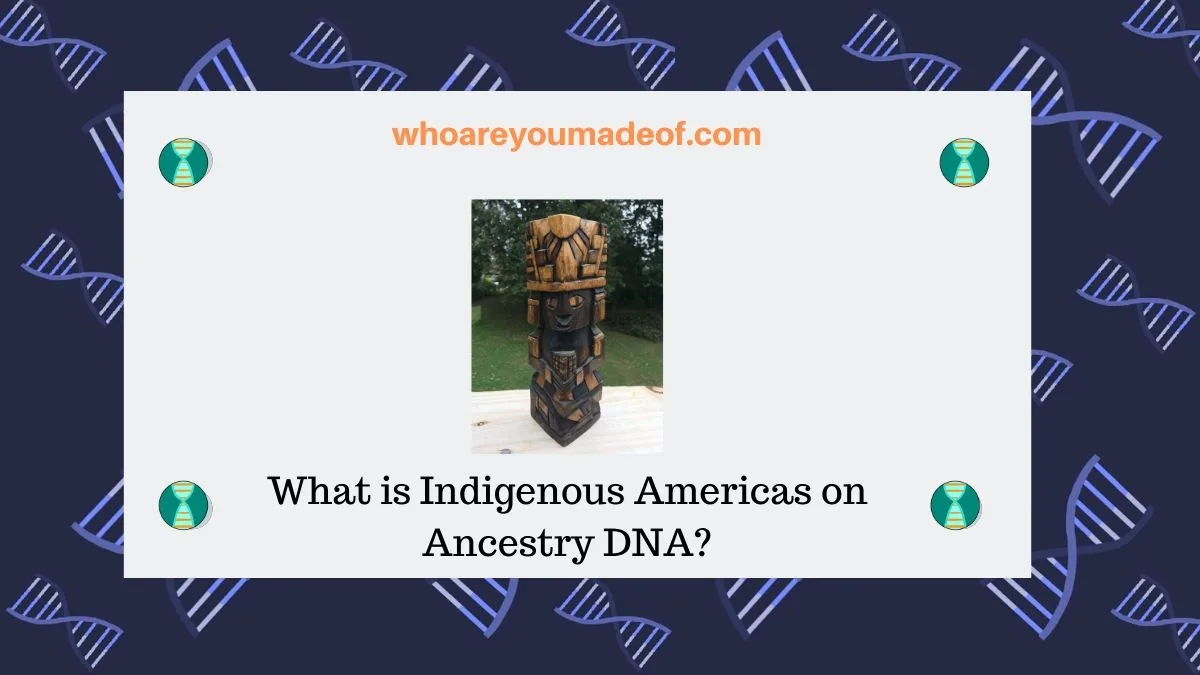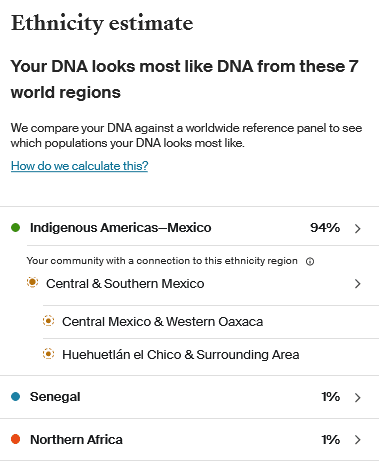In this post, you'll learn what Indigenous Americas on Ancestry DNA is, as well as how you may have inherited this region. Plus, find out how to trace your indigenous ancestry.
Whether you got 1%, 10% or 100% Indigenous Americas DNA on your Ancestry DNA results, you are in excellent company. There are more than five million Americans that identify as Native American.

What's more, there are approximately 50 million Americans with Latino or Hispanic heritage. While the average person of this ancestry has about 18% Native American, or Indigenous Americas, ancestry, many people show percentages much higher, even as high as 100%.
What are the Indigenous Americas regions on Ancestry DNA?
People who received Indigenous Americas DNA will have a more specific region within North or South America on their results. Currently, there are more than 400 sub-regions and DNA communities across fourteen main Indigenous Americas regions on Ancestry DNA:
- Indigenous Americas - Bolivia and Peru (includes Peru, Bolivia, and parts of Ecuador)
- Indigenous Americas - Central (spans across Central America)
- Indigenous Americas - Chile
- Indigenous Americas - Colombia and Venezuela
- Indigenous Americas - Ecuador
- Indigenous Americas - Mexico (includes the southwest United States)
- Indigenous Americas - Panama and Costa Rica
- Indigenous Americas - North (covers most of the United States and parts of Canada)
- Indigenous Americas - Yucatan Peninsula (located in Mexico)
- Indigenous Arctic
- Indigenous Cuba
- Indigenous Eastern South America
- Indigenous Haiti and Dominican Republic
- Indigenous Puerto Rico
All of the people with DNA from any of the regions above have ancestors who were the original inhabitants of North and South America. These people are often call themselves or are referred to (in English) as Native American, First Nations, American Indian, Amerindian, Aboriginal, or Indigenous People of the Americas.
What is Indigenous Americas DNA on Ancestry?
There is a connection between all of the regions listed above because the original populations of these continents are all descended from only a few original "populating groups" or perhaps even a single one.
The humans that crossed the land bridge into North America were then separated from Asia by immense sheets of ice during the most recent ice age.
Researchers disagree about the exactly when people from Asia crossed a land bridge (Berengia) to North America to what is now Alaska, but they do agree that it occurred at least 14,000 years ago.
Towards the end of the ice age, between 12,000-14,000 years ago, the descendants of these original peoples moved south quickly and populated the entire continents of North and South America.
How did you inherit your Indigenous Americas DNA?
As I mentioned previously in this post, we know that the original inhabitants of the Americas were all descended from a relatively small number of people who came originally from Asia.
For many reasons, including the Ice Age that occurred after the original migration(s), the people of North and South America were eventually genetically isolated for many thousands of years.
The result of this genetic isolation means that DNA from this region is easily identified on DNA ethnicity tests. This means that if you have Indigenous Americas DNA, you have a Native American ancestor, most likely from the region specified on your results.
For example, people who have Indigenous Americas - Andes on their results and have known ancestor from Chile or Peru can be confident that their heritage includes ancestry from indigenous peoples in that region.
Alternatively, those who show Indigenous Americas - North in their results can look to ancestors in what is now the Eastern, Northern, or Southern United States to find their Native American roots.

Why is there Indigenous Americas DNA outside North and South America?
It is possible for people who have no known ancestry in North or South America to have inherited DNA from distant, unknown ancestors from those regions.
We tend to think of North and South America as recipients of immigrants, but hundreds of thousands of people have left those continents over the past five hundred years.
For example, people of Mexican descent have lived in Spain for hundreds of years. Beginning about as soon as the conquest of Tenochtitlan (the original capital of Mexico), lasting through the Mexican Revolution, and continuing until this day, Spain has been a popular place for people with Mexican ancestry to live.
When you are thinking about your family tree, sometimes it's good to think outside of the box.
If you have ancestors who are from a country with current or historic close ties to any North or South American country, and you are surprised to have Indigenous Americas DNA, you should take a closer look at the family tree of those ancestors to find your connection to indigenous North or South America.
How to trace your Indigenous Americas ancestry
The best way to find out how you may have inherited your Indigenous Americas DNA is to begin tracing your family tree. Whether your Indigenous Americas ancestry is from Canada, the United States, Mexico, or Honduras, this is the way to begin.
Check out this post to learn how to build a family tree (it's easier than you think:):
How far back in family tree is 100% Indigenous American ancestor?
Exactly how far back in your family tree you will need to research to identify your "100%" Indigenous American ancestor(s) will depend on your unique family history.
It's important to know that depending on where your family has lived historically, it might be likely that many of your ancestors had Native American ancestry. For example, as many as 90% of people from Mexico have at least some indigenous ancestry.
Following this example, if you or your recent ancestors are from Mexico, this might mean that you inherited Native American DNA from more than one ancestor. Depending on where your ancestors lived in Mexico, this might mean that you have ancestry from more than one indigenous group.
There are many people with indigenous ancestry from communities within the United States and other countries who may have inherited indigenous ancestry from more than one recent ancestor.
Some people who are reading this post might have discovered a small percentage of Indigenous Americas DNA in their results, perhaps inherited from a single ancestor.
In order to know which scenario applies to you, you will need to learn about your family history. Taking the time to explore the history and traditions of the local communities where your ancestors lived will help you understand more about your indigenous roots, too.
Can DNA tell you the tribe or group your Indigenous Americas ancestors belonged to?
DNA will not be able to identify the tribe of group that your ancestors belonged to. Additionally, most tribes recognized by governments, if not all, don't accept DNA testing as evidence for membership.
Most experts will tell you that the best way to learn about which tribe your ancestors belonged to is to "follow the paper trail".
This means that you should research your family beginning with your parents and find documents connecting each generation as you work back in history towards your indigenous ancestor. You can also research the history of indigenous peoples in the geographic location where your ancestors lived in order to learn more about your Native American roots.
Conclusion
I hope that this post has helped you understand a little bit more about your Indigenous Americas DNA, how you have may inherited it, and how to trace your Native American family tree.
If you have any questions about something that you read in this post, or if you would like to share your own Indigenous Americas results, please join us in the discussion below.
Thanks for stopping by today!


Rebecca Daniels
Friday 9th of May 2025
I am excited to know that my real ancestors want me to know my story and where my home is in the ✨.
Twist
Saturday 20th of July 2024
does anyone have an idea on how to trace back Indigenous Americas -Mexico. As adoptee, I found bio relatives and maternal grand father indicated Native American in US Military documents. My own DNA indicates 53% Indigenous Americas -Mexico. Just curious if there is more I can learn when none of my bio elders are alive? Thank you
Kent
Thursday 30th of March 2023
There is a typo, Indigenous Americas Mexico includes southwest United Staes, not southeast.
Mercedes
Friday 31st of March 2023
Thank you so much for pointing that out - I just fixed it. Sincerely, Mercedes
Yivonne
Wednesday 25th of January 2023
I would love to know my ancestry and receive help with researching.
Shawna Maine Sneed
Tuesday 5th of July 2022
I am 37% Indigenous Mexico and 1% Indigenous Eucador. My great great grandparents were 100% Western Shoshone from Northern Nevada on maternal grandmothers side. On paternal grandfather my great grandmother was from the Bannock Tribe in Idaho and my great grandfather was Western Shoshone, Owyhee, Nevada. How do I have the Mexico and Eucador Indigenous?